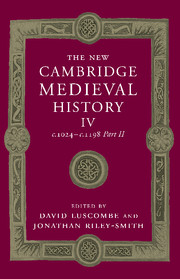Book contents
- Frontmatter
- 1 Introduction
- 2 The papacy, 1024–1122
- 3 The western empire under the Salians
- 4 Italy in the eleventh century
- 5 The kingdom of the Franks to 1108
- 6 Spain in the eleventh century
- 7 England and Normandy 1042–1137
- 8 The Byzantine Empire, 1025–1118
- 9 Kievan Rus’, the Bulgars and the southern Slavs, c. 1020 – c. 1200
- 10 Poland in the eleventh and twelfth centuries
- 11 Scandinavia in the Eleventh and Twelfth Centuries
- 12 Hungary in the Eleventh and Twelfth Centuries
- 13 The papacy, 1122–1198
- 14 The western empire, 1125–1197
- 15 Italy in the twelfth century
- 16 Spain in the twelfth century
- 17 The kingdom of the Franks from Louis VI to Philip II
- 18 England and the Angevin dominions, 1137–1204
- 19 Scotland, Wales and Ireland in the Twelfth Century
- 20 The Byzantine Empire, 1118–1204
- 21 The Latin East, 1098–1205
- 22 ’Abbasids, Fatimids and Seljuqs
- 23 Zengids, Ayyubids and Seljuqs
- Appendix: genealogical tables
- List of primary sources
- Bibliography of Secondary Works Arranged by Chapter
- Index
- Map 1a The western empire: Burgundy and Provence in the eleventh century"
- Map 1b The western empire: Germany and the north-eastern frontier of Christendom in the eleventh century"
- Map 3 The kingdom of the Franks"
- Map 4 England and Normandy"
- Map 10 Germany under Frederick Barbarossa, c. 1190">
- Map 12 The Angevin empire"
- References
23 - Zengids, Ayyubids and Seljuqs
Published online by Cambridge University Press: 28 March 2008
- Frontmatter
- 1 Introduction
- 2 The papacy, 1024–1122
- 3 The western empire under the Salians
- 4 Italy in the eleventh century
- 5 The kingdom of the Franks to 1108
- 6 Spain in the eleventh century
- 7 England and Normandy 1042–1137
- 8 The Byzantine Empire, 1025–1118
- 9 Kievan Rus’, the Bulgars and the southern Slavs, c. 1020 – c. 1200
- 10 Poland in the eleventh and twelfth centuries
- 11 Scandinavia in the Eleventh and Twelfth Centuries
- 12 Hungary in the Eleventh and Twelfth Centuries
- 13 The papacy, 1122–1198
- 14 The western empire, 1125–1197
- 15 Italy in the twelfth century
- 16 Spain in the twelfth century
- 17 The kingdom of the Franks from Louis VI to Philip II
- 18 England and the Angevin dominions, 1137–1204
- 19 Scotland, Wales and Ireland in the Twelfth Century
- 20 The Byzantine Empire, 1118–1204
- 21 The Latin East, 1098–1205
- 22 ’Abbasids, Fatimids and Seljuqs
- 23 Zengids, Ayyubids and Seljuqs
- Appendix: genealogical tables
- List of primary sources
- Bibliography of Secondary Works Arranged by Chapter
- Index
- Map 1a The western empire: Burgundy and Provence in the eleventh century"
- Map 1b The western empire: Germany and the north-eastern frontier of Christendom in the eleventh century"
- Map 3 The kingdom of the Franks"
- Map 4 England and Normandy"
- Map 10 Germany under Frederick Barbarossa, c. 1190">
- Map 12 The Angevin empire"
- References
Summary
for thirty years, from the moment he was made chief minister in 1063 by the sultan Alp Arslan (regn. 1063–72), Nizam al-Mulk devoted every effort to shaping the jerry-built Seljuqid political enterprise into a centralized absolutist monarchy. By the late 1080s, he could claim considerable success, for the sultan whom he now served (Malikshah, regn. 1072–92) enjoyed uncontested authority from the Oxus to the Mediterranean. After an initial succession struggle between Malikshah and his uncle Qavurd, there were no further disruptions which seriously threatened Malikshah’s supremacy. Nizam al-Mulk had created an administrative machinery which allowed him to maintain a fairly effective control over the flow of revenues and information. It is clear that he wanted to penetrate the whole apparatus with a network of informers and security agents, though it is not clear that he was able to achieve this goal. In any case, he dispersed his relatives and protégés everywhere he could, and even the most powerful officials in the remotest places had good reason to think that they were being watched.
Nizam al-Mulk could only use the tools available to him in the world of eleventh-century Iran and Iraq, of course. For example, he would have preferred to build a tax system based on salaried officials, but fiscal reality compelled him to make wide use of the iqta’. Even so, he strove to maintain a close supervision over these iqta’s and to limit the powers which their holders could exercise over the villages assigned to them. By this time, Seljuqid military power was based increasingly on a standing ‘professional’ army – an army whose members were registered by name, paid regular stipends and (in principle) subject to muster as needed.
- Type
- Chapter
- Information
- The New Cambridge Medieval History , pp. 721 - 752Publisher: Cambridge University PressPrint publication year: 2004

